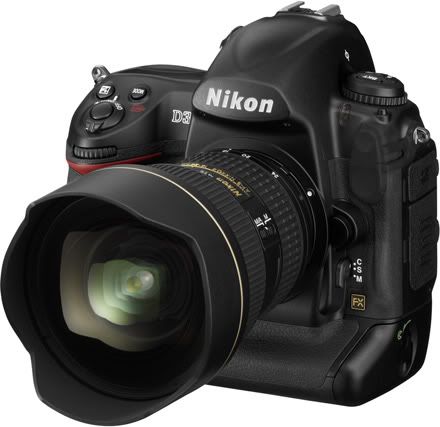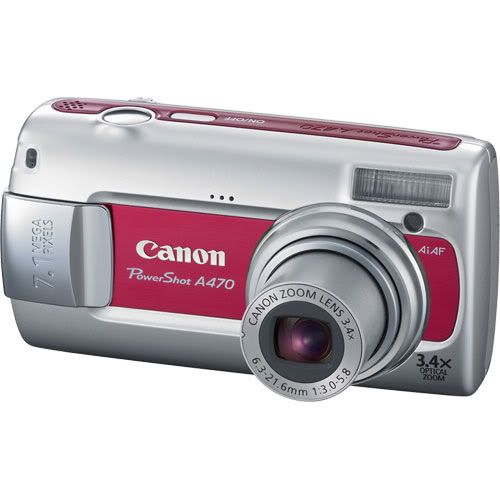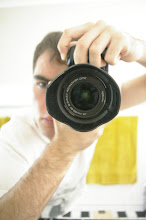I'm going to recommend that you get a camera...
Ok, it sounds obvious but things get tricky here. Spend any amount of time involved in photography, and you will quickly see how people will not hesitate spending absurd amounts of money. That said, photography can be as cheap as you're willing to be creative.
So what is a camera? A camera is a lightproof box designed to record an image.
That's all.
Lets have a look at two examples of this....
Take a look at the Nikon D3x, a top of the line SLR:

24.5 Megapixels, Price: ~ 8000 USD, plus a lens.
Schnazzy, no? But a little on the pricey side...
On the other hand look at a camera 100 times cheaper, the Canon A470

7.1 Megapixels, price: $80 USD
Now if you were to take the D3x, and put it right next to the A470, and take a picture outside of a sunny field with each, take the results down to your local camera shop and get some 6X4 prints done, there would be very few notable differences.
This would depend on which lens was on the D3 too, but my point is this - a camera is simply a tool to a purpose. A camera might be able to produce higher resolution images(more megapixels), or more vivid colours, or sharper images (a better lens), but no camera will definitively "take better pictures" than another. Not anymore than a paintbursh will paint you better landscapes, a pair of sneakers will make you a better runner or a new car will make you a better driver. Some people can take the A470 and produce fantastic images, while others can take a D3x and produce piles of mediocrity. It might be sharp, vivid mediocrity but mediocrity regardless.
Case in point - Almost any photographer today would aspire to the quality of work by the great Ansel Adams. What camera did he use? Well, a hulking massive wooden box that few modern photographers would consider using for practical work. There's more technology in that $80 camera than he could have dreamed would ever be used to make photos.
Most people are familiar with compact cameras (often called "point and shoots") like the A470 already, so I won't go into the details of their operation too much. However, I will say if you're trying to develop your photography as a hobby then you should look for a model that has manual (M), shutter priotity (Tv) and apeture priority (Av) modes, and an exposure compensation (EV) function is also very useful, though it will most likely be buried in menus somewhere.. These are modes that are on all "professional" SLR cameras and will give you much more complete control over how the camera works, and using them will help you understand how exposure works.
But mention photographer to the casual observer, and they probably think of someone with an expensive big black camera like the D3x. These are called SLR or DSLR cameras (which stands for [digital] single lens reflex). This is just a fancy way of saying they have a mirror in them which allows you to look through the lens and flips out of the way to take the photo.
If you're paying more than $500 for a camera you should expect it to do a little more than it's little sibblings. Here are some of the advantages of DSLRs over point and shoots:
Interchangeable lenses
Unlike point and shoot cameras, the lens that projects the image onto the sensor can be swapped. This has a few good things about it. By using different lenses, you can get a different field of view. Shorter focal lengths mean a wider view, while longer focal lengths give a narrower view and a more "zoomed in" image. If you are particularly interested in one area of photography, you can get specialist lenses too - a macro lens for extreme closeups, or a fisheye lens for shooting extreme sports with an unusual perspective
Bottom line - You can use different lenses to suit you, your style and your subject
Ease of use
When you look at the back (and the top... and sometimes the front) of a DSLR you will see a whole bunch of snazzy looking switches, dials and buttons. Contrary to popular belief, they are not there just to make the photographer look smarter. A serious DSLR is designed to have all of the commonly used, and most of the not so commonly used, controls accesable at the flick of a switch. This saves time digging through onscreen menus, which becomes very important if you're being payed to take photos of a kid that will only sit still for a second, or trying to get that car going by 170km/h. Though it may look daunting at first, with some learning an DSLR will become easier to use for creative photography.
Bottom line - You can change more settings quicker.
Bigger sensor size
When it comes to sensors, bigger is better. In a point and shoot, the digital sensor which records the image file is typically the size of a pinkie fingenail. A sensor that small heats up quickly, and when these sensors heat up a lot more noise (grain) comes out in images. A bigger sensor in a typical crop DSLR is a little larger tan a thumb print, so the heat is distributed more, and dissipates faster. Bigger sensors can also take advantage of better designed lenses, allowing for sharper images.
Bottom line: You get a clearer image.
Shutter lag and startup time
Point and shoot cameras have come a long way in this regard, but even now many have a noticeable gap between pressing the shutter button to take a picture, and the image being recorded. If you've ever tried to take photos of fast moving objects, you'll probably have noticed this. On a DSLR the shutter lag is minimal, to the point of not being noticeable (less than a tenth of a second). Also, the startup and focusing time is much faster - one you hit the power switch, the camera will be ready to take a photo in around half a second, as opposed to 2-3 seconds for a lot of point and shoot cameras
Bottom line: It's easier to capture fast moving objects or spontanious shots.
Pretty neat eh? Well why doesn't everyone use these things all the time? There are some less touted downsides to those big, expesnive looking cameras -
They're big
There is no way you're going to slip that Dx3 in your jeans pocket. If you're looking for some spontainous family snaps while out and about, size might be a problem. If you're looking to travel the world out of a single suitcase, size might be a problem. If you want to take your camera where ever you go, then be prepared to start carrying a backpack everywhere too.
They're expensive looking
If you can't just wack that camera in a jacket pocket easily, then you have to look at another option. To protect their camera, and keep it on eaily accessable a lot of photographers will hang it on a neckstrap, or in a purpuse built camera bag. Problem is, now you have a sign over your head that "I have a piece of equiptment on me worth between $800 and $8000". Camera bags are often targeted by theives in airports. Personaly I have been lucky enough to never have gear stolen, but it is always a possibility. That said, gear can be insured if it's a serious worry.
They're actually expensive
You should be prepared to spend $6-700 on a new DSLR setup. Thats with a kit lens, a bag, lens cleaner, and a cheap tripod. If you hunt around for an older model in good condition (which will do the job just fine) and some second hand lenses, you can get the bare bones for under $450, likely without a bag, tripod or cleaner. Another lens will give you more focal lengths to work with would be anywhere fromm $200 - $2000 depending on your needs. After that, you will likely want to get your camera and sensor cleaned once a year if changing lenses regularly (dust gets inside the body), at some point those shiney pro lenses will look very appealing (but not to your wallet) and you will find all sorts of ways you'd love to drop money on this new toy of yours.
You need will need time to learn to use them
Yes, you can put a DSLR on full Auto mode and come up with a slightly higher quality point and shoot camera. However, you will need to spend at least a bit of time understanding the camera and it's technology beyond "This button takes a picture". If that bothers you, then a DSLR is probably not for you.
Another important consideration for a casual user is the fact most DSLRs will not record video. Some are emerging with this capability now along with a live view.
Also, increasingly there is crossover between the two classes. EVF (electronic view finders) will look deceptivly like an SLR, but have an electronic display in the viewfinder and a fixed lens. Some of these can cost over $800, and at in my opinion at that price point a DSLR is a far more versitile investment.
So the final verdict? If you are serious about photography, seriously consider investing in a DSLR straight away. It will give you the opportunity to learn the most the quickest. If you're uncertain, don't discount a point and shoot.
For now, lick onwards folks.
But mention photographer to the casual observer, and they probably think of someone with an expensive big black camera like the D3x. These are called SLR or DSLR cameras (which stands for [digital] single lens reflex). This is just a fancy way of saying they have a mirror in them which allows you to look through the lens and flips out of the way to take the photo.
If you're paying more than $500 for a camera you should expect it to do a little more than it's little sibblings. Here are some of the advantages of DSLRs over point and shoots:
Interchangeable lenses
Unlike point and shoot cameras, the lens that projects the image onto the sensor can be swapped. This has a few good things about it. By using different lenses, you can get a different field of view. Shorter focal lengths mean a wider view, while longer focal lengths give a narrower view and a more "zoomed in" image. If you are particularly interested in one area of photography, you can get specialist lenses too - a macro lens for extreme closeups, or a fisheye lens for shooting extreme sports with an unusual perspective
Bottom line - You can use different lenses to suit you, your style and your subject
Ease of use
When you look at the back (and the top... and sometimes the front) of a DSLR you will see a whole bunch of snazzy looking switches, dials and buttons. Contrary to popular belief, they are not there just to make the photographer look smarter. A serious DSLR is designed to have all of the commonly used, and most of the not so commonly used, controls accesable at the flick of a switch. This saves time digging through onscreen menus, which becomes very important if you're being payed to take photos of a kid that will only sit still for a second, or trying to get that car going by 170km/h. Though it may look daunting at first, with some learning an DSLR will become easier to use for creative photography.
Bottom line - You can change more settings quicker.
Bigger sensor size
When it comes to sensors, bigger is better. In a point and shoot, the digital sensor which records the image file is typically the size of a pinkie fingenail. A sensor that small heats up quickly, and when these sensors heat up a lot more noise (grain) comes out in images. A bigger sensor in a typical crop DSLR is a little larger tan a thumb print, so the heat is distributed more, and dissipates faster. Bigger sensors can also take advantage of better designed lenses, allowing for sharper images.
Bottom line: You get a clearer image.
Shutter lag and startup time
Point and shoot cameras have come a long way in this regard, but even now many have a noticeable gap between pressing the shutter button to take a picture, and the image being recorded. If you've ever tried to take photos of fast moving objects, you'll probably have noticed this. On a DSLR the shutter lag is minimal, to the point of not being noticeable (less than a tenth of a second). Also, the startup and focusing time is much faster - one you hit the power switch, the camera will be ready to take a photo in around half a second, as opposed to 2-3 seconds for a lot of point and shoot cameras
Bottom line: It's easier to capture fast moving objects or spontanious shots.
Pretty neat eh? Well why doesn't everyone use these things all the time? There are some less touted downsides to those big, expesnive looking cameras -
They're big
There is no way you're going to slip that Dx3 in your jeans pocket. If you're looking for some spontainous family snaps while out and about, size might be a problem. If you're looking to travel the world out of a single suitcase, size might be a problem. If you want to take your camera where ever you go, then be prepared to start carrying a backpack everywhere too.
They're expensive looking
If you can't just wack that camera in a jacket pocket easily, then you have to look at another option. To protect their camera, and keep it on eaily accessable a lot of photographers will hang it on a neckstrap, or in a purpuse built camera bag. Problem is, now you have a sign over your head that "I have a piece of equiptment on me worth between $800 and $8000". Camera bags are often targeted by theives in airports. Personaly I have been lucky enough to never have gear stolen, but it is always a possibility. That said, gear can be insured if it's a serious worry.
They're actually expensive
You should be prepared to spend $6-700 on a new DSLR setup. Thats with a kit lens, a bag, lens cleaner, and a cheap tripod. If you hunt around for an older model in good condition (which will do the job just fine) and some second hand lenses, you can get the bare bones for under $450, likely without a bag, tripod or cleaner. Another lens will give you more focal lengths to work with would be anywhere fromm $200 - $2000 depending on your needs. After that, you will likely want to get your camera and sensor cleaned once a year if changing lenses regularly (dust gets inside the body), at some point those shiney pro lenses will look very appealing (but not to your wallet) and you will find all sorts of ways you'd love to drop money on this new toy of yours.
You need will need time to learn to use them
Yes, you can put a DSLR on full Auto mode and come up with a slightly higher quality point and shoot camera. However, you will need to spend at least a bit of time understanding the camera and it's technology beyond "This button takes a picture". If that bothers you, then a DSLR is probably not for you.
Another important consideration for a casual user is the fact most DSLRs will not record video. Some are emerging with this capability now along with a live view.
Also, increasingly there is crossover between the two classes. EVF (electronic view finders) will look deceptivly like an SLR, but have an electronic display in the viewfinder and a fixed lens. Some of these can cost over $800, and at in my opinion at that price point a DSLR is a far more versitile investment.
So the final verdict? If you are serious about photography, seriously consider investing in a DSLR straight away. It will give you the opportunity to learn the most the quickest. If you're uncertain, don't discount a point and shoot.
For now, lick onwards folks.

No comments:
Post a Comment